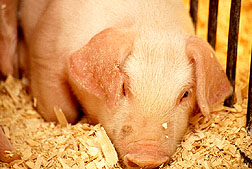New Tests for Chlamydia Strains
Chlamydia is a bacterium that can survive only by growing inside other living cells.
There are over 60 strains that can infect most birds and mammals, including humans. In humans, Chlamydia causes an eye infection leading to blindness (trachoma), sexually transmitted diseases, and respiratory disease. It has recently been associated with coronary atherosclerosis.
In animals, Chlamydia causes respiratory disease, conjunctivitis, arthritis, enteritis, and reproductive failure. In birds, it produces a generalized infection resulting in lethargy and sometimes death.
Until recently, the primary way to study this ubiquitous bacterium in the laboratory has been to grow it in cell culture or in fertilized chicken eggs.
Now, Agricultural Research Service (ARS) scientists at the National Animal Disease Center in Ames, Iowa-- the only researchers in the United States who study a large variety of non-human chlamydial strains--have tests that will enable scientists and laboratory diagnosticians to detect any kind of Chlamydia and to identify its species.
Developed by veterinarian Arthur A. Andersen and molecular biologist Karin D. E. Everett, the tests use polymerase chain reaction (PCR) to target genetic material found in all chlamydial strains. The only DNA-based test now available--one that identifies human chlamydial strains--doesn't detect animals strains, which in some cases affect humans.
The new tests to diagnose Chlamydia take only about 4 hours, compared to 2 to 4 days--or longer--needed to isolate the organism in tissue culture. An added bonus: The tests don't require culturing specimens, thus reducing human exposure to bacteria. ARS is pursuing a patent for the tests.
The diseases and host range associated with each strain are related to their species classification. Currently, the strains fall into four species: C. trachomatis, C. psittaci, C. pneumoniae, and C. pecorum. Because the tests provide more detailed information about each species, the scientists are reclassifying Chlamydiaceae into nine groups.
The new tests will help veterinarians diagnose and improve treatment for sick birds and animals. Most important: They will help answer questions about where people and animals become infected.
The researchers are currently studying Chlamydia in pigs. Even though Chlamydia has been known to occur in pigs for over 40 years, it has been very difficult to isolate. Andersen and ARS biological laboratory technician Linda Hornung and University of Nebraska veterinarian Douglas Rogers in Lincoln have isolated it from healthy and diseased pigs.
The new diagnostic test could also replace slower and less reliable tests used by veterinarians to detect infected birds and prevent their sale as pets.
"One of our goals is to find out how widespread this bacterial organism is among animals and what problems it's causing. We know that Chlamydia is widespread in birds and animals and that it often is not properly diagnosed," says Andersen.--By Linda Cooke McGraw, Agricultural Research Service Information Staff.
Arthur A. Andersen and Karin D. E. Everett are in the USDA-ARS Avian and Swine Respiratory Diseases Research Unit, National Animal Disease Center, P.O. Box 70, Ames, IA 50010; phone (515) 239-8338, fax (515) 239-8458.
"New Tests for Chlamydia Strains" was published in the June 1998 issue of Agricultural Research magazine. Click here to see this issue's table of contents







